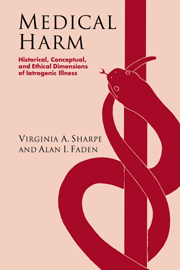Book contents
- Frontmatter
- Contents
- Acknowledgments
- Introduction
- Part I
- Part II
- Part III
- 7 From hospitalism to nosocomial infection control
- 8 Adverse effects of drug treatment
- 9 Unnecessary surgery
- 10 The concept of appropriateness in patient care
- 11 Recommendations for limiting iatrogenic harm
- Appendix
- Bibliography
- Index
9 - Unnecessary surgery
Published online by Cambridge University Press: 22 September 2009
- Frontmatter
- Contents
- Acknowledgments
- Introduction
- Part I
- Part II
- Part III
- 7 From hospitalism to nosocomial infection control
- 8 Adverse effects of drug treatment
- 9 Unnecessary surgery
- 10 The concept of appropriateness in patient care
- 11 Recommendations for limiting iatrogenic harm
- Appendix
- Bibliography
- Index
Summary
In the context of surgery, the term ‘iatrogenic illness’ or ‘iatrogenic complication’ has been reserved for surgical mishaps and adverse surgical outcomes. Although these outcomes may secondarily give rise to an assessment that a procedure was itself unnecessary or inappropriate, unnecessary surgery per se has not traditionally been recognized as an iatrogenic harm. One explanation for this may be that attention to unnecessary surgery has primarily come from private or governmental insurers who have tended to focus on the direct aggregate economic costs of the phenomenon rather than on its indirect or intangible human costs in morbidity, mortality, pain, suffering, or loss of livelihood to individuals. In other words, from the point of view of health policy, unnecessary surgery has been understood principally as a problem of ‘surgical overuse’ rather than iatrogenic harm. Another reason why unnecessary surgery has not itself been regarded as a patient harm may be a general skepticism about even the occurrence of unnecessary surgery. If we understand an unnecessary surgery to be one that offers no anticipated preponderance of benefit to the patient, then many would argue that no doctor would perform such a surgery. This view is of course countered by another common impression that such surgeries do occur and that the only identifiable benefits that accrue from them are remunerative ones to the physician.
In this chapter, we explore both what is meant by the term unnecessary surgery and the evidence that has been offered to explain the scope and nature of the problem.
- Type
- Chapter
- Information
- Medical HarmHistorical, Conceptual and Ethical Dimensions of Iatrogenic Illness, pp. 194 - 212Publisher: Cambridge University PressPrint publication year: 1998



